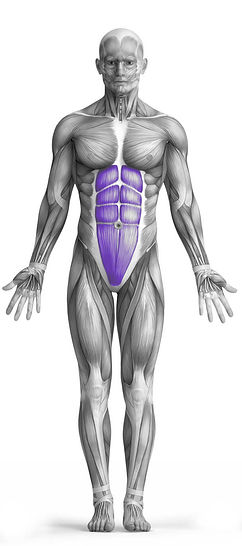Russian Twist 101 Video Tutorial
0

Exercise Synopsis
Target Muscle Group
Abs
Secondary Targets
Execution
Isolation
Force Type
Pull
Required Equipment
Bodyweight
Fitness Level
Intermediate
Variations
None
Alternatives
Timer
Hour
Minute
Second
Stopwatch
00:00:00:00
Overview
The Russian Twist is a core-strengthening exercise that primarily targets the abdominal muscles while also engaging the obliques and lower back. It involves sitting on the floor with knees bent and feet lifted off the ground, leaning back slightly to engage the core. Holding a weight or using bodyweight alone, the torso is twisted from side to side, aiming to touch the ground or a weight to the floor on each side. This dynamic movement challenges the core muscles to stabilize the spine and pelvis while rotating, enhancing overall core strength and stability. With its focus on bodyweight resistance, the Russian Twist is accessible to individuals of varying fitness levels and serves as a valuable addition to any core-focused workout routine.
How to Perform
Prepare for the Russian Twist exercise by laying down on a comfortable surface such as a mat, ensuring your back is fully supported.
Bend your knees and lift your feet off the ground, forming a right angle with your calves and thighs to engage the core muscles effectively.
Place one hand over the other with palms facing towards your feet and extend your arms towards the ceiling to initiate the movement.
Lift your shoulder blades off the mat, engaging your abdominal muscles to stabilize your torso.
Rotate your torso to the left, rolling your hands and arms along with the movement, and then return to the center before twisting to the right side.
Lower your shoulder blades back down to the mat with control, maintaining tension in the core throughout the exercise.
Repeat the entire sequence for the desired number of repetitions, focusing on smooth and controlled movements to effectively target the abs, obliques, and lower back muscles.
Ensure to breathe steadily throughout the exercise, exhaling as you twist and inhaling as you return to the starting position, to support core stability and maximize energy efficiency.
★ Bonus: For exercises that involve external weights (such as dumbbells, barbells, or machines), the One Rep Max (1RM) calculator can help you estimate your maximum lifting capacity. Use it to track your strength progress and adjust your training for optimal results.
Tips
Increase the intensity of the Russian Twist by lifting your shoulder blades higher off the mat, intensifying the engagement of the targeted muscles, particularly the abs, while challenging the obliques and lower back further.
For a more advanced variation of the exercise, incorporate a dumbbell into your routine by holding it firmly with both hands. This additional weight increases resistance, enhancing the effectiveness of the workout and providing a greater challenge to your core muscles.
How Not to Perform
Avoid rounding your lower back during the Russian Twist, as this can lead to strain or injury. Maintain a neutral spine position throughout the exercise to effectively engage the abs and protect the lower back.
Do not rely solely on momentum to perform the movement. Instead, focus on controlled and deliberate twists, using the strength of your core muscles to rotate your torso rather than relying on swinging motions.
Refrain from fully collapsing your chest or shoulders towards the ground during the twist. Maintain a lifted and engaged upper body to maximize activation of the abs and obliques.
Avoid holding your breath. Remember to breathe steadily and rhythmically throughout the exercise to support core stability and optimize energy efficiency.
Do not neglect proper alignment. Ensure that your knees, hips, and shoulders remain in line throughout the movement, avoiding any excessive twisting or tilting of the pelvis.
Avoid gripping the ground or mat with your feet. Keep your feet relaxed and focus on engaging the core muscles to stabilize your body during the twist.
Do not hyperextend your neck or strain your shoulders. Keep your neck relaxed and your shoulders away from your ears to prevent tension buildup in the upper body and maintain focus on the targeted muscle groups.
Avoid over-twisting your torso beyond a comfortable range of motion. Focus on quality over quantity, performing each repetition with control and precision to effectively engage the abs, obliques, and lower back muscles.
Variations
Variations of fitness exercises refer to different ways of performing a specific exercise or movement to target various muscle groups, intensities, or goals. These variations aim to challenge the body differently, prevent plateaus, and cater to individuals with varying fitness levels.
Alternatives
Alternative exercises in fitness refer to different movements or activities that target similar muscle groups or serve the same training purpose as the primary exercise. These alternative exercises can be used as substitutes when the original exercise is unavailable or challenging to perform due to various reasons such as equipment limitations, injuries, or personal preferences.








